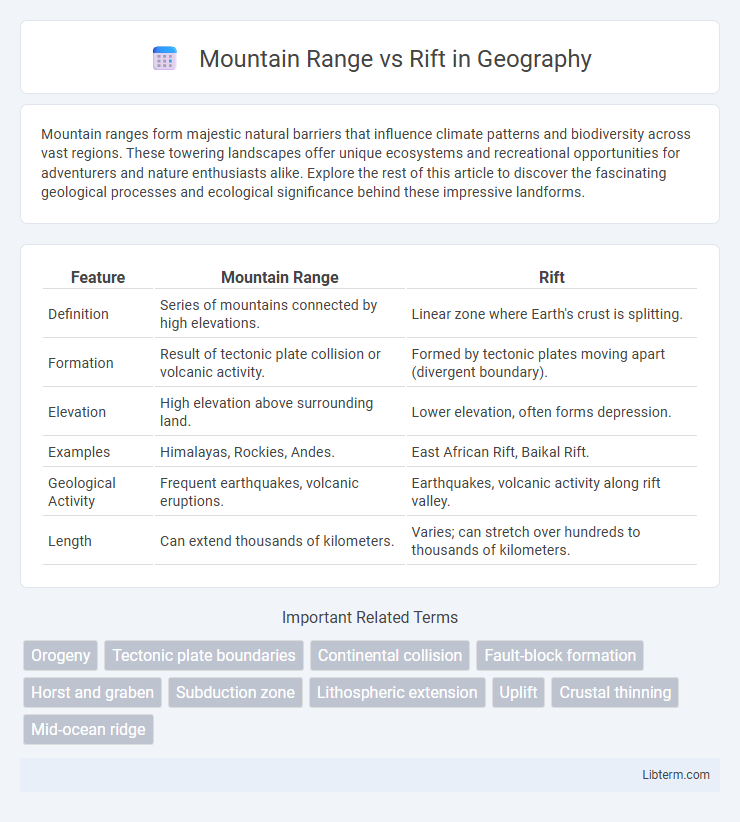Mountain ranges form majestic natural barriers that influence climate patterns and biodiversity across vast regions. These towering landscapes offer unique ecosystems and recreational opportunities for adventurers and nature enthusiasts alike. Explore the rest of this article to discover the fascinating geological processes and ecological significance behind these impressive landforms.
Table of Comparison
| Feature | Mountain Range | Rift |
|---|---|---|
| Definition | Series of mountains connected by high elevations. | Linear zone where Earth's crust is splitting. |
| Formation | Result of tectonic plate collision or volcanic activity. | Formed by tectonic plates moving apart (divergent boundary). |
| Elevation | High elevation above surrounding land. | Lower elevation, often forms depression. |
| Examples | Himalayas, Rockies, Andes. | East African Rift, Baikal Rift. |
| Geological Activity | Frequent earthquakes, volcanic eruptions. | Earthquakes, volcanic activity along rift valley. |
| Length | Can extend thousands of kilometers. | Varies; can stretch over hundreds to thousands of kilometers. |
Introduction to Mountain Ranges and Rifts
Mountain ranges form through tectonic forces that push Earth's crust upward, creating elevated landforms often characterized by rugged peaks and valleys. Rifts develop when tectonic plates pull apart, causing the crust to thin and sink, resulting in elongated depressions or basins. Understanding these contrasting geological structures highlights the dynamic processes shaping Earth's surface.
Defining Mountain Ranges: Formation and Features
Mountain ranges form through tectonic plate collisions causing the Earth's crust to fold and uplift, creating elongated chains of peaks and valleys. These ranges often exhibit rugged topography with high elevations, sharp ridges, and significant geological diversity including metamorphic and igneous rocks. Unlike rifts, which are characterized by crustal extension and the formation of fault valleys or basins, mountain ranges result primarily from compressional forces and crustal thickening.
Understanding Rifts: Geological Origins and Characteristics
Rifts form when tectonic plates move apart, creating elongated valleys marked by fractures and faulting within the Earth's crust. Unlike mountain ranges, which result from compressional forces pushing plates together, rifts are characterized by crustal thinning and subsidence that often lead to volcanic activity and basin development. The East African Rift exemplifies a prominent active rift zone, illustrating how extensional tectonics reshape the landscape and contribute to continental breakup processes.
Key Differences Between Mountain Ranges and Rifts
Mountain ranges form from tectonic plate collisions that cause crustal uplift and folding, resulting in elevated landforms with steep slopes. Rifts occur where tectonic plates pull apart, leading to crustal thinning and the creation of elongated lowlands or valleys. The fundamental difference lies in mountain ranges being compressional features caused by convergent boundaries, while rifts are extensional features formed at divergent boundaries.
Plate Tectonics: Drivers Behind Ranges and Rifts
Mountain ranges form primarily at convergent plate boundaries where tectonic plates collide, causing crustal material to fold and uplift, while rifts develop at divergent boundaries where plates pull apart, thinning the crust and creating faults. The Himalayan Range exemplifies a collision-driven mountain range formed by the Indian and Eurasian plates, whereas the East African Rift illustrates active continental rifting with significant crustal extension. Plate tectonics governs these distinct geological features through mechanisms of compression in mountain building and tension in rift formation.
Famous Mountain Ranges Around the World
Famous mountain ranges like the Himalayas, Andes, and Rockies form through tectonic plate collisions, creating towering peaks and rugged landscapes. Rift zones, such as the East African Rift, result from tectonic plates pulling apart, forming valleys and volcanic activity rather than high mountain chains. These geological processes distinctly shape Earth's topography, with mountain ranges representing convergent boundaries and rifts indicating divergent boundaries.
Notable Rift Zones Across the Globe
Notable rift zones such as the East African Rift, the Rio Grande Rift in North America, and the Baikal Rift in Siberia exemplify areas where tectonic plates are diverging, creating elongated valleys and volcanic activity distinct from mountain ranges formed by convergent plate boundaries. These rift zones feature active faulting, geothermal phenomena, and significant crustal thinning that contrast with the uplift and folding processes shaping mountain ranges like the Himalayas or the Rockies. Studying rift zones provides critical insights into continental breakup, seismic hazards, and the dynamic geological evolution of Earth's lithosphere.
Environmental Impact: Mountains vs. Rifts
Mountain ranges significantly influence local climates by acting as barriers to wind and precipitation, fostering diverse ecosystems and affecting water cycles through snowpack accumulation and gradual melt. Rift valleys, formed by tectonic plate divergence, often create unique habitats with volcanic soil deposits and geothermal activity, but can also lead to increased seismic activity and land subsidence that disrupt ecosystems. Both geological features shape biodiversity, yet mountains tend to support high-altitude flora and fauna, whereas rifts promote specialized species adapted to dynamic earth processes and varying moisture conditions.
Human Settlement and Activity in Mountain and Rift Zones
Mountain ranges host diverse human settlements that adapt to high altitudes, utilizing terraced farming, mining, and tourism to sustain livelihoods. Rift zones, characterized by tectonic activity and fertile valleys, support agriculture, geothermal energy extraction, and infrastructure development despite seismic risks. Both environments influence population distribution, economic activities, and cultural practices shaped by their distinctive geophysical features.
Conclusion: Mountains and Rifts in Earth’s Dynamic Landscape
Mountain ranges form primarily through tectonic plate collisions, creating elevated terrains with complex geological structures, while rifts develop where plates pull apart, leading to crustal thinning and valley formation. Both features illustrate Earth's dynamic tectonic processes, shaping landscapes through uplift and subsidence. Understanding mountain ranges and rifts reveals the ongoing evolution of Earth's surface driven by plate tectonics and mantle dynamics.
Mountain Range Infographic

 libterm.com
libterm.com